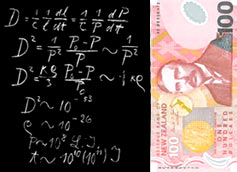

Wednesday - October 10, 2007
SLAC Today is
available online at:
http://today.slac.stanford.edu
In this issue:
symmetry: The Particle Physics Life List
People Today: Mike Saleski - Artistic Renegade
Incident Investigation
Energy Tip of the Week
 |
 |
|
Wednesday - October 10, 2007 |
symmetry: The Particle Physics Life List
A blackboard still showing Einstein's notes from a 1930s lecture (left) and New Zealand's $100 bill
(right).
Bird watchers have "life lists" of species they hope to see in their lifetimes. Why shouldn't particle physics fans do the same? With that in mind, symmetry asked readers to help put together the first particle physics life list. Here it is, in no particular order, with items ranging from the silly to the sublime. This is not meant to be a comprehensive account of great figures or historical moments; rather, it's a checklist of things you can see or do today, some as common as crows and others as hard to spot as the ivory-billed woodpecker. Some require special access, and rules for visitors vary and may change; so before you go out of your way to bag one of these items, call ahead. On the other hand, many physics labs offer tours and are more accessible than you think! A few items from the list: - See the never-erased notes Einstein made on a blackboard during a lecture he gave at Oxford University in the 1930s. - Spend a Rutherford, Bohr, Birkeland or Tesla. Four physicists are featured on currency: Ernest Rutherford on New Zealand's $100 bill, Niels Bohr on the Danish 500 kroner note, Kristian Birkeland on the Norwegian 200 kroner and Nikola Tesla on the Serbian 100 dinar. - Visit SLAC's theory fish tank, where there are no fish; just a glass-fronted room lined with chalkboards where theorists hold discussions. Read more in symmetry... |
||
|
|
||

Mike Saleski:
|
Incident Investigation
At about 8:00 a.m. on September 13, 2007, there was a pipe blow-out at Sector 30 of the linac. The lab takes such events very seriously, and SLAC and the Department of Energy (DOE) Site Office agreed that SLAC should undertake a vigorous and rigorous evaluation of what went wrong and why. Acting SLAC Director Persis Drell appointed a committee of seven SLAC people—Bob Hettel, Keith Jobe, Frank O'Neill, Liam Robinson, Brian Sherin, Steve Williams (chair) and Harvey Lynch—to undertake the evaluation. In addition, SLAC brought in a professional accident investigator, Bob Crowley, retired from the DOE. Representatives from the Site Office and Stanford University were invited as observers to validate the process. The committee began its investigation on September 24 with a charge to find a root cause and provide recommendations to the laboratory director to reduce the potential for similar accidents. The group met daily through October 5 gathering information, interviewing people, collecting and studying documents, and analyzing the data. A report is in preparation; a link to the report will be published in SLAC Today when it becomes available. The committee was dedicated to conducting the investigation rigorously, constructing the incident timeline and scrutinizing the conditions associated with that timeline. Bob Crowley led vigorous discussions on what those conditions indicated and, most importantly, why they existed. Separating facts from speculation is essential and the committee constantly asked, "What is the evidence for that?" Given the conditions and looking for potential causes, the committee went through a process called the "Five Whys," where each "why" is a drill-down of the answer to the previous "why" question. The committee found the process to be very helpful and informative. The process was efficient because the committee members know the lab and the people, and could study the situation in great depth. The committee would like to thank all the people interviewed for their great cooperation and dedication to aiding the investigation. Energy Tip of the WeekIt's not too soon to start thinking about the cold weather on the horizon. To save money and energy on heating, apply these tips from PG&E, where and when appropriate. You can save as much as 2 to 3% of the energy your furnace uses simply by lowering your thermostat 1° F (if it's set between 65° and 72° F). Open window coverings on sunny days to help warm rooms. Turn down your furnace when using your fireplace, and close the damper when not using the fireplace. |
Events (see all | submit)
Access (see all)
Announcements
|
| | ||
|
|
||
 <%
Response.AddHeader "Last-modified", getArticleDate()
'Response.AddHeader "Last-modified","Mon, 01 Sep 1997 01:03:33 GMT"
'Monday, December 06, 2010
%>
<%
Response.AddHeader "Last-modified", getArticleDate()
'Response.AddHeader "Last-modified","Mon, 01 Sep 1997 01:03:33 GMT"
'Monday, December 06, 2010
%>View online at http://today.slac.stanford.edu/. |
||